Interesting facts about Agra Fort | Historical Facts of Agra Fort

- By
- Aparna Patel
- |
- 23 Oct, 2019
- |
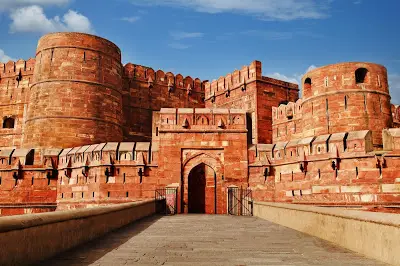
Agra Fort – The fort of Agra used to be the royal fort of the Mughal empire in history. This fort is also included in the UNESCO World Heritage Site and it is situated only 2.5 kilometers from Agra’s famous Taj Mahal.This fort is often known as the city of walls.This fort is constructed with red sandstone, hence this fort is also called the “Red Fort” of Agra. Due to its grandeur and attractiveness, it is also one of the main tourist destinations in India.The complex of this fort includes the finest buildings of the Mughals including Pearl Mosque, Diwan-i-Aam, Jahangiri Mahal, Moti Masjid, Pearl Mosque.
In this article, we are going to tell you about some interesting fun facts and general information related to this huge fort of Agra and its history.
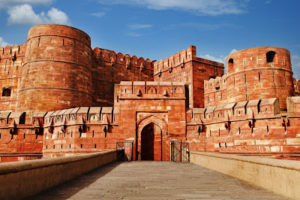
Amazing Famous Facts About Agra Fort For Tourists
1.Agra’s fort was built by the Mughals, the fort of Agra is a fort built with brick which was known as Badalgarh, which belonged to the Hindu-Sikarwar Rajput king Badal Singh.This fort was included in the list of World Heritage Site by UNESCO in the year 1983 AD due to its magnificent structure and royal design.
2.When the army of Ghaznavi attacked the fort in 1080 AD, this fort was first mentioned in history. Sikandar Lodi (1488-1517) was the first sultan of Delhi, which later moved to Agra and stayed in the fort. He had given importance to Agra during his reign. But then in 1517, he died in the fort and his son Ibrahim Lodi took care of the fort for next nine years. During his reign, he had constructed many mosques, walls and royal houses around the fort.
3.After the first war of Panipat in 1526, the victorious Babur stayed in the fort. He later constructed Baoli in the fort. After this, Humayun was crowned in 1530.
4.When Akbar knew the importance of Agra then he declared Agra the capital of his empire in 1558.
5.According to his historian Abul-Fazl, the fort of Agra was earlier a fort built by the brick which was known as Badalgarh. At that time, its condition was very bad and then Akbar rebuild it with red stone.
6.According to the architect, the brick was used in the inner part of this fort and the outer part was decorated with red stones. It is said that about 4000 workers had made this fort in about 8 years by working every day and its construction work was completed in 1573.
7.It was completed in the time of Shah Jahan, and therefore Shah Jahan declared Agra as his state. History says that Shah Jahan had built a beautiful Taj Mahal in the memory of his wife Mumtaz. It is said that Shah Jahan was very fond of making memorials and forts.
8.At the beginning of the 18th century, the Maratha empire had acquired this fort. But Ahmad Shah Abdali defeated Maratha in the third war of Panipat in 1761.After this, Marathas were outside the area for almost 1 decade. And finally, in 1857, Mahadji Shinde won the fort.
9.The fort of Agra has been declared as World Heritage by UNESCO. Sikandar Lodhi, Mahmud Ghaznavi, the kings of Chauhan dynasty also spent some time in this fort. Mughal Emperor Babur, Humayun, Akbar, Jahangir, Shahjahan, and Aurangzeb used to rule the country from here.
10.Rashid, an expert in history, points out that Agra fort was built of bricks first. It was called Badalgarh at the time of Chauhan dynasty kings. In the year 1080, the army of Mahmud Gaznavi took this fort from the Chauhan king. After the war of Panipat, the Mughals captured this fort. Then it is known as “Agra Fort”.
11.The wall of Agra Fort is 70 feet high. Walls of cannons and defense posts are also built on the walls. Gates are built on its four corners. The gate to the Yamuna has been closed by the Archaeological Survey of India (ASI) from the brick wall. The second door is called the Delhi Gate. This Gate is the under of the army. While the Lahore Gate is open for tourist. It is now called Amar Singh Gate.
12.There were about 500 beautiful buildings in Agra Fort. It was made in Bengali, Gujarati and Mughal style. After the occupation of the British, the fort was brought into use for the army. Most of the buildings were broken by the British in 1803-1862. Now there are only thirty buildings left.
13.In Diwan-i-Khas, Jahangir constructed a black throne for the meeting.The throne broke down in the attack of a cannon from the river Yamuna. Although it was so strong that where the cannonball fell, there was a slight crater. It can still be seen. Jahangir used this place in the meeting with high officials.
14.In Agra Fort, Shah Jahan was imprisoned by his son Aurangzeb.
15.The treasury was kept in the fort of Agra, which also had a special diamond, now known as Kohinoor diamond. This diamond took the British and now in the custody of the Queen of Britain.
16.Agra Fort, a unique Mughal architecture building included in the World Heritage List, was built primarily for military defense.
17.The construction work of Agra Fort took about 8 years, while about 4 thousand artisans built this huge fort.
18.There are 9 very magnificent and luxurious palaces inside the complex of this huge fort of Agra. These include Bengali Mahal, Akbari Mahal, Jahangir Mahal, Shah Jahani Mahal, Machchi Bhawan, Diwan-i-Aam, Diwan-i-Khas, Khas Mahal, and Sheesh Mahal etc.
19.This famous fort of Agra has been awarded with the Aga Khan Award for its unique architecture in the year 2004. At the same time, the Indian Postal Department had also issued a stamp to celebrate the event.
20.Construction of Agra Fort –
Agra Fort is situated on the banks of river Yamuna in Agra, Uttar Pradesh, this huge fort was built by the Mughal emperor Akbar between 1565 and 1573 AD.However, it is written on the entry of this fort that this huge fortress included in the World Heritage was originally built even before 1000 AD, and the Mughal ruler Akbar only renovated this fort.
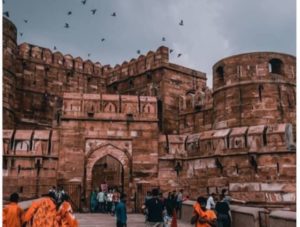
However, from time to time changes have been made in this fort by different rulers. Shah Jahan, the grandson of the Mughal emperor Akbar and the heir of the Mughal Empire, built a very attractive and delightful mosque inside the fort using beautiful white marble stones.Along with this, Shah Jahan also used the fort of Agra as a palace when the Mughal capital was shifted from Agra to Delhi.
After this, Aurangzeb, the ruthless son of Shah Jahan, built the outer guard of Agra Fort. Let us tell you that when Aurangzeb become Successor of the Mughal Empire, then he imprisoned his father Shah Jahan in this fort in the last days of his life.It is also said that from this fort, Shah Jahan used to see the Taj Mahal, one of the seven wonders of the world built-in memory of his Mumtaz Begum.
Read More About Taj Mahal-Amazing Facts About Taj Mahal
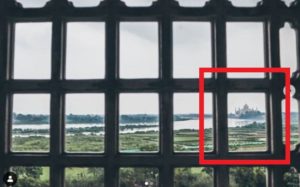
21.Interesting history of Agra Fort
The history of the huge fort of Agra is associated with the Rajputs, the Mughals, and the Lodi dynasty.Let me tell you that due to the historical importance of Agra, it used to be the capital of Delhi. The history of the construction of Agra Fort dates back to 1080 AD when Mahmud Ghaznavi’s army established its dominance over this fort to conquer India.
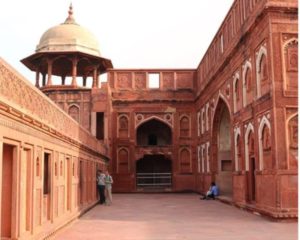
According to historians, this fort was originally occupied by the Rajput rulers of the Chauhan dynasty.
After this, when the first Sultan of Delhi Sultanate and ruler of Lodi dynasty Sikander Lodi shifted his capital from Delhi to Agra, then he repaired this fort and later resided in this fort.
After the death of Sikandar Lodi, his son, and successor of the Lodi dynasty, Ibrahim Lodi had established his suzerainty over the fort and the Mughals had established their rule in this fort after victory in the First War of Panipat in 1526 AD.
After this, Humayun, the successor of the Mughal Empire, not only took possession of the Agra Fort but also confiscated the immense wealth of the Lodis and the huge treasure which also contained the famous Kohinoor diamond.
22.When the Mughals lost possession of Agra Fort
In 1530, when Humayun was crowned as the successor of the Mughal Emperor, a few years later, he faced with Sher Shah Suri in about 1540 AD.
In which Humayun was defeated and thus the Mughal authority was taken away from Agra Fort. In this way, Sher Shah Suri ruled this fort for about 15 years.
23.In 1555 AD, the Mughals regained control of Agra Fort
Subsequently, in 1555 AD, when the Mughal Emperor Humayun and Sher Shah Suri fought again, Humayun defeated Sher Shah Suri and regained control over Agra Fort.
24.When Akbar was made the successor of the Mughal Empire
After the death of Mughal emperor Humayun, his stunning son Akbar become Successor of the Mughal Empire at the age of 13.
After which Akbar embarked on his political tour to strengthen the position of the Mughals and reached Agra in 1558 AD and realizing the historical significance of this city, he made Agra his capital.According to historians, the Agra Fort (Badalgarh Fort) at the time of Akbar’s rule was in a worse condition, at that time it was just a brick fort.
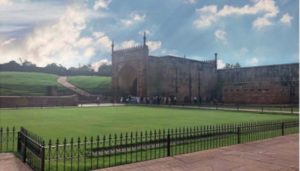
Akbar decided to rebuild and recovered the remains of Badalgarh Fort and started the construction of this fort with red sandstone from Dholpur district of Rajasthan in about 1565 AD.With the help of several thousand artisans, the construction of this fort was completed in 1573 AD after a long time of about 8 years.
25.Mughal Emperor Shah Jahan destroyed parts of Agra Fort
According to some historians, Shah Jahan, the grandson of Mughal emperor Akbar, demolished some of the buildings behind this fort during his reign to build buildings built of white marble stones. After this, Shah Jahan used marble stones inside this huge fort and also built other buildings including the mosque and in this way, Shah Jahan gave this fort the present form
26.Agra Fort became witness to Indian independence struggle in 1857
The Maratha Empire established its rule over this world heritage Agra fort in the early 18th century. After this, many different rulers took possession of this fort.Let us tell you that after the defeat of the Maratha ruler in the third battle of Panipat in 1761 AD, Ahmad Shah Abdali established his suzerainty over this fort.
After this, Mahadji Shinde ruled this fort in 1785 AD, during the Second Anglo-Maratha War in 1803 AD, the British gained control over this huge fort of Agra and used this fort for their works.The fort of Agra became a battleground during the first battle of India’s independence (Indian independence struggle) in 1857 AD. After this, the fort was ruled by the British till August 15, 1947, for about a century. In 2004, this fort was also awarded the Aga Khan Award for its unique architecture.
27.Amazing architecture and unique architecture of Agra Fort
Situated on the banks of river Yamuna in Agra, this world heritage is built in a semicircular shape. This huge fort is spread over an area of 380,000 sq m (94 acres).This fort is surrounded by walls from all sides, the height of these walls is about 70 feet. Red sandstone has been used in the construction of this fort, hence this fort is also called the “Red Fort” of Agra.There are currently more than 24 monuments inside this magnificent fort located about two and a half kilometers from the Taj Mahal.
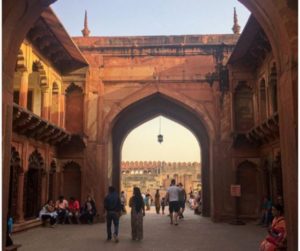
According to the historian Abul Fazal, inside this famous historical heritage of India, about 500 very beautiful and attractive buildings were built in Bengali and Gujarati architecture. But most of these buildings were destroyed during the reigns of Shah Jahan and the British.
When the British took control of this huge fort spread over an area of 3 kilometers, the original structure of this fort was severely tampered with and many changes were made in it. The British destroyed many of its buildings to build barracks inside this fort.
The only surviving remains of this fort are the Akbari Gate, the Delhi Gate, and the Bengali Palace still in existence today, which present the true complexity and exquisite workmanship of Mughal architecture.The grand and royal rooms built inside this historic World Heritage Agra Fort were constructed in such a way that it would be cool even in summer.
General Information about Agra
- Country – India
- State – Uttar Pradesh
- Division – Agra
- District – Agra
- Establishment – 16th century
- Founded – Sultan Sikandar
- Elevation – 171 m (561 ft)
- Location – Agra, Uttar Pradesh
- Sex ratio – 0.875 ♂/♀
- LiteracyRate (2011) – 73.11%
- Total Population – 5.9 lakhs 2011)
- Males Population (2011) – 2,364,953
- Females Population (2011) – 2,053,844
- Language – Hindi
- Villages – 906
- Weather – 22 °C, Wind E at 3 km/h, 63% Humidity
- Winter temperature – 10°C to 25°C
- Summer temperature- 30°C to 40°C
- Latitude and Longitude – 27.1767° N, 78.0081° E
- Annual Mean Temperature – 25.6 °C. About 745 mm
- Average Annual Precipitation – 736.6mm (29″)
- Area – 10,863 Sq. Km.
- Sea Level – 560ft.
- Road Distance
From Dehradun-440 km
From Delhi-240 km
From Kolkata-280 km
From Mumbai-1210 km
Famous and important buildings built inside Agra Fort
Many unique structures remain inside this historic Agra Fort, which is as follows –
1.Jahangir Mahal Agra
A very beautiful and attractive Jahangir Mahal is located in the complex of this World Heritage located in Agra. This palace was built by the Mughal emperor Akbar for his son Jahangir.
2.Anguri Bagh
Angoori Bagh built in the premises of Agra Fort also adorns this grand fort, it is spread over an area of about 85 square meters.
3.Khas Mahal
The Khas Mahal inside this huge fort in Agra is famous for its unique structure. This very attractive structure is built using white marble stones.The construction of the Khas Mahal reflects Hindu, Islamic and Persian styles. The Khas Mahal was used to rest by the emperors.
4.Musamman Burj
It is an open pavilion made in octagonal shape. This bastion was built by the Mughal Emperor Shah Jahan.
5.Sheesh Mahal Agra
The Shish Mahal, built inside the Agra Fort, this masterpiece of Mughal architectural style, is one of the best structures built in the premises of this fort.Sheesh Mahal or ‘Kanch Ka Mahal’ was used as a dressing room or ‘haram’ by the emperors. Inside this palace, very magnificent decoration has been done with glass.
6.Diwan-e-Khas –
The Diwan-i-Khas is located on the right side of the Sheesh Mahal built in the premises of the World Heritage Agra Fort. It was used by the emperors for any major officials’ meetings, etc.
7.Diwan I Aam Agra Fort
The Diwan-i-Aam was constructed for the general public in the Agra Fort complex.In this special building, the common people were heard by the emperors and their problems were resolved. A famous Mayur throne or Takht-e-House was also established inside the Diwan-i-Aam.
8.Nagina Mosque – Nagina Masjid Agra Fort
The Nagina Mosque was built by the Mughal Emperor Shah Jahan inside the premises of the famous historical heritage Agra Fort. Let us tell you that this mosque was built as a private mosque for the ladies of the court.
9.Moti Masjid – Moti Masjid Agra
Moti Masjid is a very attractive and beautiful structure located in the World Heritage Agra Fort. This mosque was the private mosque of the Mughal Emperor Shah Jahan, where he used to worship Allah. However, tourists are not allowed to visit the Moti Masjid.
10.Naubat Khana – Naubat Khana
Inside Naubat Khana, emperor’s musicians used to enchant them by playing instruments.
Time to visit Agra Fort
Tourists can visit the fort of Agra 6 days a week. This fort is closed for tourists on Friday.
Read More Unkown facts
Lal Qila Agra Tour
You can easily go to the Red Fort of Agra. It is connected to airways, roads, and railways. Agra has located 4.5 km from Cant Railway Station.The nearest airport is Agra Airport. If you know any new things about Agra Fort then tell through the comments so that other people can also read, thank you.
Search Posts
Latest posts
-
4 Mar, 2024
Can I accidentally miss the in-flight food?
-
5 Mar, 2024
Passing through airport security with autism
Popular posts
-
5 Mar, 2024
Why prohibit engine braking?